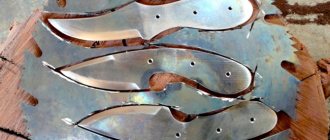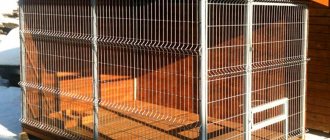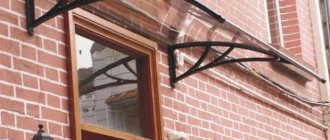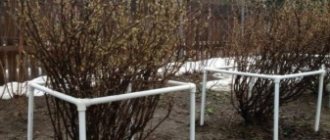Good afternoon - today I have prepared a BIG and NECESSARY article to help everyone who has seriously set out to make a wooden canopy adjacent to a private house with their own hands. That is, I will tell you step by step what simple steps (and they are really simple) consist of building a canopy against the wall of a house. We will make wooden sheds with a polycarbonate roof. We will look at different design options for the same canopy model for a house - that is, we will learn how to create different canopy designs based on one drawing - for any home, for any needs. And after reading the article, you will not only LEARN how to make canopies , but you will also be able to implement any design of a wooden canopy for a private home.
After all, when you understand the ESSENCE of the design, you will be able to modify this design according to your creative imagination. And who knows, maybe you will even earn a living later as a master of an attachment craft.
We will consider the following questions in turn.
- A canopy for a house - its basic elements
- How to change the design of basic elements and get different canopy designs for your home.
- How step by step .
Let's first look at the classic wood canopy.
CLASSIC SHAPE
CANNOT TO THE HOUSE
So, here (photo below) is a sample of what we will learn to do with our own hands. We see a classic lean-to canopy against the wall of the house. Such a canopy for a house can be made not only at a blank wall - exactly the same canopy structure can be made at the front entrance of the house, in the back yard for gatherings and anywhere, it doesn’t matter, the principle is the same.
THE GENERAL PRINCIPLE OF ALL CANOPIES is that one edge of the canopy is attached to the wall - and the other edge stands on support posts. That is, the canopy to the house must have two types of support - on poles and on the wall.
This is the essence of all hanging buildings... however, making holes in the wall to nail a support beam to it is NOT NECESSARY - below you will see models of canopies where the fasteners do not need to be driven into the wall, but you can install the same SUPPORT POSTS at the wall of the house as on the outer edge of the canopy. So, if you don’t want to make holes in a beautifully plastered wall, don’t rush to leave the article, there will be canopy options for your case too.
The simplest canopy for the house.
(CANOPY OPTION No. 1 - with material savings)
If you have few wooden beams, but have a task to make a canopy for the house from these small ones. Then you can make a simple design like this (photo below). A total of 5 beams are needed - 2 for support pillars + 3 for load-bearing beams.
Here, the load-bearing side beams are attached to the wall using METAL FASTENERS (the photo below shows what they are like). Such metal brackets are attached to the wall of the house and the ends of the two side beams of our canopy are inserted into them.
The roof in such a canopy attached to the house can be a sheet of polycarbonate (transparent or darkened) ... or the roof can be an awning-curtain that slides along a stretched metal string (and either moves apart like a tent or gathers against the wall like curtains). I talked more about such a curtain roof for canopies in the article How to make a roof for a canopy and pergola
.
Go ahead…
Let's take a more complex canopy... Although its complexity is purely conditional... The essence is basically the same - but this model is already close to the classic design of a canopy attached to a house. The most understandable drawing, without unnecessary elements. Only the basic elements...
- support pillars
- load-bearing beam on the wall
- load-bearing beam on support pillars
- roof sheathing beams (for laying polycarbonate sheets on them)
This is a classic - a BASIC part of any awning. And starting from these basic elements, we will create a great variety of canopy designs for the house.
And to start from the very beginning, we must start from the BOTTOM... from the substrate, from the foundation on which our canopy will stand.
Stage VI. Roofing pie device
What is insulation? First of all, it is a waterproofing film, which is located directly under the roofing. The main task is to prevent moisture from getting in after rain or from melted snow through problem areas in the roofing.
If this is planned, you will do everything in the following sequence:
- Step 1. Place a vapor barrier film on the finished canopy joists and nail it in place using nails or a construction stapler.
- Step 2. Place thermal insulation on the film.
- Step 3. Cover it all with another film - waterproofing. Also nail it to the joists.
- Step 4. Nail the batten and roofing on top.
Ventilation of such a roof is mandatory. Forced, if you install a special fan, or natural, if you position the dormer window correctly or leave a mandatory gap between the waterproofing film and the insulation so that the air takes moisture droplets from it.
Wooden flooring under the canopy.
(flat wooden base)
Before making a canopy, we need to figure out what we want in the final version - A CANOPY ON THE GROUND (so that the support pillars are dug into the ground, into concrete)... or A CANOPY WITH A BOARD FLOOR (where the support posts are attached to a wooden flooring)?... Let's look at the projects of canopies and Let's understand our desires and preferences.
Here (photo above) you can clearly see that first the man laid a neat wooden flooring... And then he installed a canopy on it.
If you're building a shade shelter for your backyard patio, it's smart to make a comfortable wood deck as the floor.
We start by leveling the soil surface where there will be a canopy near the house.
After this, we need to lay the sheathing of our future wooden flooring on the soil...
we cover the base sheathing (we nail them to the sheathing)
You can take long boards at full length (as in the photo below)
Or if our boards are short, then they can be laid out at random... in a checkerboard pattern (as in the photo below).
What to do if you need flooring, but the canopy is already on concrete.
Let's say you decided to make a country canopy... and you did... And now you want there to be a neat wooden flooring . So that the furniture can be arranged, put a rug. Here is a photo example of how this can be implemented. We lay the sheathing on posts (if you want to raise the flooring above the ground).
If the soil or concrete foundation in front of the house is uneven in height, then the support columns will be of different heights - for different soil levels - somewhere longer, somewhere shorter. Here you will need to clearly calculate the height
support columns - so that the beams lying on them are all at the same level - in the same plane.
After that, all that remains is to pave it all with boards - and your flooring is ready for the canopy adjacent to the house.
Here is another photo example of a high deck under a wooden canopy near a house. It is built on the same principle - support posts + sheathing + flooring made of boards. And (what I liked) the side planes of the flooring are sewn up here - special panels with holes for ventilation are nailed on all sides.
If you are making a canopy at a door with a high level above the ground (that is, your house has a high foundation), then the wooden flooring under such a canopy should also be high + you need to build a porch into it to go down from this pedestal. This is just such a project for flooring under a canopy - for a house with a high foundation (photo below). A very picturesque picture - a side porch with flowerbeds on the sides and illuminated steps.
Concrete base
under a canopy near the house.
You can also make a BASE UNDER THE CANOPY in the form of a concrete blind area (regular or paved with tiles)
And here is the base for the canopy, which I really like - high concrete formwork
We cast a high side from concrete (or lay it out of brick) - we give this side an elegant cladding to look like rough stone. It turns out beautiful.
This option is also good if you have support beams of insufficient height... And such formwork will raise your wooden canopy to the level you need.
Here is a similar principle, where the support pillars of the canopy stand on rocky hills. This allows you to use even short cuts of beams in the construction of sheds.
Here is another example of a canopy where support poles that are short in length are used. The support beams were placed on specially built brick walls. The result is a canopy with short legs and a beautiful wall, which can then be decorated in an interesting way and covered with decorative stone. Place a bench and fireplace nearby.
Or such a stone side wall for our wooden canopy can be decorated in an oriental style - come up with a fountain there, put flowerpots and pots with plants + stick night lanterns. And what you will get is not just a simple canopy near the house, but a magical corner where you can so comfortably retire or talk about good topics with a friend.
So, we have figured out the BASE for canopies... Now let's see what other canopies there are. And first of all, let's look at the canopy project, for which you do not need to damage the wall of the house.
What is the best material to make a canopy in the yard for practical reasons?
Currently, the choice of modern building materials is quite large. But the most popular for building a canopy are polycarbonate and metal profiles, which are often also called corrugated sheets or corrugated sheets.
These two materials have completely different characteristics, but both are successfully used for the construction of canopies.
Here we will compare them in terms of cost and operational parameters.
We just need to immediately decide by what criteria we will compare polycarbonate and metal profiles.
The most important to me are strength and durability, ease of installation, light transmission, appearance and, of course, price.
In addition, you need to take into account the material from which the canopy frame will be made.
So, let's start with polycarbonate.
without fastening to the wall of the house.
And remember, I promised to show a wooden canopy near the house, which does not need to be attached to the wall (no need to drill holes and spoil the elegant facade of the house). Here is this model - such a canopy stands on 4 support pillars (or more pillars are possible) ... and it is not attached to the wall - it simply adjoins it, that is, it stands close to it (see options for wooden canopies in the photo below)
Such a canopy (not attached, but attached to the wall of the house) is also not at all difficult to make yourself. It is precisely these structures (supported by 4 pillars) that we examined in great detail in the article-lesson “How to make a canopy - THE MOST CLEAR LESSON.”
And such a free-standing canopy near the house can be decorated with false columns. False columns are available at home improvement stores and can simply be wrapped around your regular wooden shed beams. That is, hide each supporting pillar of the canopy inside such an elegant Greek false column.
Now look at the powerful potential hidden in your new skill of “making awnings with your own hands”...
What should you pay attention to when purchasing a substrate?
Planting material should be purchased at trusted specialized retail outlets. Preference should be given to sawdust, which contains fungal spores - they are more resistant to disease.
Also, a sawdust substrate is much more fruitful than others, because it allows the root system of fungi to take root and spread better.
with a terrace on the second floor.
If you are the owner of a private TWO-STORY house, then why just make a canopy over the porch. Make a canopy along the entire facade of the house - place it on weight on powerful support pillars of thick section - and... MAKE A TERRACE ON THE ROOF OF THE CANNOT.
It's a good idea... Agree.
After all, this is the right idea . Since you have decided to make a canopy near your house... Then why not think about the future. Make a canopy right away on thick powerful beams-pillars. And then next year, continue construction on the roof of your canopy - attach a railing with balusters - and now you have the opportunity to sit high above the ground - with a cup of tea from a samovar on a wooden terrace made with your own hands. And remember that it all started with your humble desire to make some kind of canopy...
My only advice: it is better to make such structures on the south side of the house (the north side is poorly lit and it is not advisable to additionally darken it with a canopy - there will be less light in the house and the walls will become damp).
Design
Quite often a situation arises when it is necessary to erect a canopy or canopy over a building. This is a fairly simple design that any man can build without any special skills. There are many ideas for this building on the Internet. However, it is necessary to take into account certain design features to ensure that the canopy lasts a long time and properly.
It is necessary to take into account the climatic features of the area in which the canopy is created, the location of the building on the cardinal points, and the features of the foundation of the building
It is equally important to choose the right coating
The easiest way to create a canopy or canopy is when it is attached to an already finished building. The more thoughtful the project, the easier it is to make all kinds of calculations of the required material. There are no small details in construction, and absolutely everything needs to be taken into account. If the calculations are made correctly, and the project includes a variety of little things, then construction will proceed with ease.
canopy support ON THE WALL.
First, you need to decide AT WHAT LEVEL you need to make a hanging beam on the wall. This is important because... If you want the roof of the canopy to be level (without slope) so that you can walk on it, so that you can make a terrace on it in the future... then the level of your beam on the wall must coincide with the level of the beam on the pillars - that is, they should be at the same height from the ground.
If you are not planning any terraces on the roof of the canopy - but you want this roof to be sloped so that the snow slides off it on its own (that is, you need a canopy with a pitched roof), then you need to nail the load-bearing beam to the wall HIGHER than the beam on the supporting ones pillars Here in the photo below I show an example of this thought of mine. Where the load-bearing beam near the wall (arrow 1) is higher in level than the load-bearing beam on the pillars (arrow 2). And due to this different height, we get a canopy with a sloping pitched roof.
Now, let's look at the ways in which this beam can be attached to the wall, or what other fasteners (besides the beam) can be used to attach the canopy to the wall of the house.
Method one - Support in the form of a beam.
We simply attach a horizontal beam to the wall (with self-tapping screws) - it will hold the roof of our canopy (we will lay our cross beams directly on it for sheathing the roof).
And so that you do not doubt the reliability of fastening the beam, you can attach an entire beam-holding mechanism to the wall - in the shape of a square (see photo with a red arrow below).
Method two - Vertical racks against the wall.
If you got the beams for the support pillars of a smaller diameter... and the load on the roof of the canopy is planned to be more serious (i.e. you want to make the roof sheathing also from heavy beams)... THEN you need to ADDITIONALLY REINFORCE your load-bearing beam on the wall and also the load-bearing beam, which lies on the pillars
We see that the load-bearing horizontal beam (attached to the wall) is reinforced with additional vertical support beams (arrow 1). Thus, the canopy attached to the house does not rest its entire weight on the wall beam, but distributes its weight onto the wall posts and beams.
And the supporting vertical pillars at the other end of the pergola (i.e. those at the outer end of the porch) have diagonal short support beams that hold the second load-bearing horizontal beam (arrow 2).
By the way (in the photo above), pay attention to WHAT THE SUPPORT POSTS STAND ON... They are based on metal bearings on a high thick metal leg, which is screwed into the flooring boards.
Here is another photo where the canopy has support beams right next to the wall of the house . It’s safer this way: you don’t have to worry about the wall, in case the beam falls off the wall under the weight of time. Additional pillars against the wall will prevent this from happening.
The third method is support in the form of metal brackets.
We attach brackets-holders to the wall (stone or wood or brick)... This is how we see in the photo below... And we place our side cross beams on them (as on model No. 1 of the canopy from this article).
An important condition: not every wall is suitable for such fasteners. If the wall is tiny, or made of porous material (foam blocks, for example), then the fasteners will not adhere well to the wall. And you must understand that heavy beams will sooner or later fall on the heads of your neighbors.
Therefore, consult with specialists. It’s better to choose the fastening method in which there is not a single bit of doubt - that is, the one where there are additional vertical posts along the wall that support a horizontal beam on the wall (see the second method).
Construction and installation work
During any construction there are usual work algorithms. The early stages are practically the same; the differences begin during the construction of the structure.
Clearing the area for construction. This includes cleaning the soil (if the site is filled), clearing debris, tools, and other things.
Site marking. Performed according to the drawing (sketch).
At the site of future support pillars, it is necessary to dig holes about a meter deep (for structures with a height of no more than 3 m in the center). Pit dimensions: 40 by 40 cm, depth 1 m. Usually, there are 6 such holes, but sometimes 8 are made.
Installation of support posts for the canopy frame. There are some nuances here. When constructing supports made of metal or pipes, they must be anchored and concreted. In this case, the hole expands. The anchor must be no shorter than half the length of the underground dimension of the structure. All pipes must have the same length and must be aligned using a level or level.
The pillars must be fastened together to improve the rigidity of the structure. To do this, frame elements are mounted on top, but of a smaller diameter along the entire perimeter at the same level.
Roof installation. The rafter system, prepared in advance, is welded right on site, level. Usually they take a step of 1 m, the angle is selected in the sketch and it is advisable to calculate it. But most often there are designs with an angle of 30-40 degrees.
The rafters are welded at the joint with the external contour so that the flooring protrudes beyond the structure, providing good waterproofing and protection from excess moisture.
The final stage of installation will be roof sheathing. More often they use polycarbonate or profile flooring. If we talk about corrugated sheeting, it is laid overlapping, from bottom to top (hitting the edge). The overlap is about 15 cm. It is trimmed at the ridge, after which it is sheathed with tin.
In cases with polycarbonate, the sheets are laid end-to-end, after which they must be coated with waterproofing (acrylic, silicone). Both elements are attached to self-tapping screws with washers.
It is advisable to attach them to a small dab of silicone for better insulation and to prevent oxidation of the thread at the joint. What to make the canopy from is up to you.
install SUPPORT POSTS.
I described this stage in detail in the article How to make a pergola canopy - the most detailed lesson. All 4 methods of installing poles are described there - both in the ground, and on a concrete foundation, and on a wooden flooring... And here I will only show a photo of the options for fastening elements for support poles. Or you can simply dig them into the ground (after tarring them and wrapping them in roofing material so that they do not rot in the ground).
Thrust bearings (or anchors) serve to protect wooden posts from rotting. U-shaped and T-shaped anchors are best suited for this purpose. They allow the beam to rise 2 cm above the surface. Be blown by the breeze and do not retain rain moisture.
If you bury your poles in the ground, it is better to use thrust bearings with long anchors (in the form of a reinforcement rod or pipe) - this way the metal part of the pole will be in the ground, and the wooden part on the surface.
And if you don't want to spend money on steel bearings. And just dig the pillars into the cement foundation the old fashioned way, then don’t be too lazy to tar the part of the beam that will go into the ground before doing this. Resin will extend the life of the wood, protecting it from rot. Instead of tarring, ordinary roofing felt is often used . They wrap it around the underground part of the timber, and tightly wrap this roofing material “swaddling” with metal wire. Place the end of the pillar wrapped in roofing felt in the hole and fill it with cement.
And the support pillars for the canopy can be made OF BRICK MASONRY and lined with decorative stone. Like in the photo below.
Projects
As is the case with any other buildings on the site, before erecting a canopy it is important to develop a competent plan for the future structure. First, the master must draw up detailed drawings indicating absolutely all dimensional parameters and nuances of the structure
Only having a carefully drawn project at hand can you count on its high quality and quick construction without unnecessary errors.
You can draw up a project for a future building yourself, but this can be difficult to do if the home craftsman does not have extensive experience in such matters. In order not to waste time and avoid serious shortcomings in the drawings, it is advisable to use ready-made plans for canopies for parking spaces on the site. Let's look at several optimal projects.
A good gable canopy for a parking space can be built from bars with a section of 100x100 and 50x100. The height of the structure can be 2 m, and the width – 2.7 m. The structure will be neat and will be quite enough to accommodate one car.
place the BEARING BEAM on the pillars.
You will decide for yourself how to place the beam on the pillars. I'll show you several ways to attach a load-bearing beam to support posts, and you choose.
Method one (beam on top of pillars)
We place the beam on top of the post and fix it with long screws (central photo) or metal plates (right photo).
To prevent the supporting beam from bending on the support pillars under the weight of the roof sheathing, it can be REINFORCED. To do this, add diagonal beams (see extreme examples in the photo) or add an extended beam in the center (central example in the photo below).
Method two (beam from above into grooves on support pillars).
We cut out a hole-groove in each support column. And we put our load-bearing beam into this groove. Naturally, this method is suitable if our beam has a side that is thinner in size than the thickness of the support column.
Method two - instead of a beam there are 2 boards.
This method is remarkable because it saves material (boards are cheaper than beams). And in terms of endurance, 2 boards are equal to one beam. We fill two boards on both sides of the support post and together they act as a regular load-bearing beam - see the photo of the canopy structures below.
I described all these methods of laying load-bearing beams on poles (for the roof of a country house) in the article “Canopy for a country house - 10 WAYS to do it yourself.” So if something is not clear here, you can find additional explanations in this article on how to make a canopy at home with your own hands.
Stage III. Construction of the foundation
So, we’ve decided on the material – it’s time to start construction:
- Step 1. So, we dig cylindrical holes. Make the depth from 60 centimeters to 90. In total, for this option we will need 6 holes.
- Step 2. We prepare the concrete separately, for example, in an old bathtub, where it is easy to mix cement and sand with gravel. Take the proportions 1:3:5. Add water.
- Step 3. Mix well and pour a layer of concrete into the holes so that the thickness is 5 centimeters, and lower the pipes there. They will serve as formwork for the foundation.
- Step 4. Now we fix the pipes from the outside. Fill with concrete.
- Step 5. Level the pipes and make shelves for them from boards.
- Step 6. Now we wait three days for the mixture to harden. The easiest way to install wooden posts on such a foundation is with an anchor, which is installed on completely hardened concrete.
- Step 7. Now we connect the support beams to this pillar. We screw the boards with self-tapping screws so that they protrude about 3 centimeters beyond the edges of each post. And on the side these protrusions will be needed to fasten the crossbar of the sheathing.
- Step 8. To give the entire structure greater rigidity, especially if the anchors have come loose, use spacers. The spacers are cut at an angle of 45 degrees and screwed with self-tapping screws.
That's all! The hardest part is behind us.
canopy roof lathing
The first method is lathing over the beams.
simply lay the sheathing boards of the beams. And fasten it with metal corners. Like in the photos of the house canopy below.
The second method is on the grooves.
We cut grooves in the sheathing boards. And we put these grooves on the supporting beam. The difficulty here is that the grooves at the ends of the boards must coincide with the beams (therefore, the boards must first be dragged up, laid out on the roof, marked with a pencil where the grooves will be cut, then removed, sawed out the grooves, and lifted onto the roof again).
The second method is butt to butt.
This method is also possible, but the sheathing beams must be adjusted to fit snugly to snugly in order to fit neatly into the metal holder ears.
Roof for canopy
(roofing felt, polycarbonate, slate, tiles)
The most beautiful type of roof is transparent polycarbonate. This way there will always be light under the canopy. Such a roof is required if this side of the house faces north, so that excess darkness does not accumulate under the canopy.
If the canopy is on the sunny side of the house, and you instead want to reduce the sun above your head and sit in the shade of the canopy. Then you can choose any opaque roof - cheap roofing felt and slate, or more expensive soft tiles, or chalkboard.
Important: Do not forget to waterproof the junction of the canopy and the wall. To do this, you need to buy and nail a small iron visor. As in the photo below.
An elegant addition to a canopy.
You can cover the space between the support pillars with panels with sheathing. They are easy to manufacture - a regular rectangular frame made of thin blocks - and a thin strip is criss-crossed onto them. You can plant vines next to such a sheathing - they will beautifully crawl up the pergola.
As a result, you will have a gazebo adjacent to the house. There you can put a table and benches for gatherings with friends and neighbors.
By the way, I also have an article on making benches with my own hands.
In the meantime, while the grapes are growing, you can plant your canopy using pots - just build a green wall of pots with lush bushes near the supporting pillars of the canopy. And we hang flowerpots with flowers on the supporting beam of the canopy.
You can also design on a piece of paper - sketch out a sketch of a stone flowerbed next to the canopy. And next year we will bring it to life.
Here are simple ways to create canopies with your own hands - at a private home or country house.
And for dessert...
When your canopy is ready and you are beaming with happiness and pride, think about how you can make the canopy even more elegant.
For example, paint the canopy elegant white. Then it will look completely festive. White paint turns even a very heavy structure into a light and airy one.
And if you made a canopy for the back patio (for cozy gatherings ), then buy fabrics and sew some elegant curtains for your new canopy. They can be hung on metal strings stretched between the support posts of your country canopy. This way you will get an almost oriental tent in your backyard of a private house.
And next year, you can develop a project plan for landscaping the area around your new shed (photo below) . After all, if you have found a master carpenter inside of you... who knows, maybe a designer mason is hiding next to him.
Draw a sketch of your area around the canopy, consult with your smart wife and for the next construction season arrange, for example, a stone area like this, with benches and a fireplace for a cozy fire.
By the way, to help you - my article “HEARTHERE in the country - 7 WAYS to make it with your own hands.”
You see how interesting it is to make a canopy with your own hands ... believe in your hands... and continue to create beauty around you... This is very useful. Because when you are doing good things, there is no time to do bad or sad things... And if there is a lot of beauty in life, then there is no room for despondency.
Get busy living or get busy dying...
Take care of your health or take care of your illness...
Deal with fear or deal with courage
Engage in despondency, or engage in creating something new
We ourselves choose what to do... So let's choose to create something new and useful... Because by creating something, we create ourselves. The best version of ourselves.
Forward. You just need to start... then continue... and then finish. It's simple.
If I weren't a girl... I would build this myself. But all I can do is inspire boys. Therefore, it’s up to you to build))), dear boys.
Good luck with your dacha construction. Olga Klishevskaya, especially for the website “Family Kuchka”
If you liked this article and you want to thank the free author for this painstaking work, then you can send any amount convenient for you to his personal wallet YAD - 410012568032614
Canopy over the door
This type is the most common. Its design should be combined with the overall appearance of the building.
A wooden canopy is suitable, for example, for a structure made of logs. It protects the entrance from external factors. It must be durable to withstand the snow mass in winter and have a water drainage system.
It is more convenient to make a single-pitched canopy on supports over the porch.
Protective
They are applied over tinting to obtain a smooth, clean surface that preserves the natural beauty of the wood for a long time.
The most popular surfaces lately are those on which the natural texture of wood is visible. Sometimes, for the sake of sophistication, artificial creation of cracks with spraying is added to obtain the appearance of aged timber.
To maintain a natural look, finishing begins with tinting the surface with light shades, moving on to darker ones.
"Summer cuisine"
In the summer you want to cook outdoors: it’s more pleasant and economical. For the kitchen you will need: barbecue, oven, table, benches, washbasin.
A summer kitchen will allow you to host family dinners or friendly gatherings outside. You can have a barbecue here.
Tree selection
In order to build a canopy, they take wood from moisture-resistant species: beech, pine, oak, larch.
For expensive canopies, radial cutting (the central part of the trunk) and chamber drying are used (heated in a chamber so that the material does not shrink or crack).
For this you can use various lumber:
- beam;
- log (for supports);
- bars (for visors);
- slats;
- lining, board, panels.
Exterior
Wooden canopies are well combined with stone, polycarbonate, concrete, metal, which emphasize the beauty of wood, merging with the natural landscape.
They can serve as a support for ornamental hanging plants, flowering perennials such as clematis, wisteria, climbing roses or for climbers such as maiden grapes or ivy.
Landscaping will hide us from prying eyes, protect us from drafts and heat, and add romance to the area.
For comfort, you can install light and install lighting fixtures.











